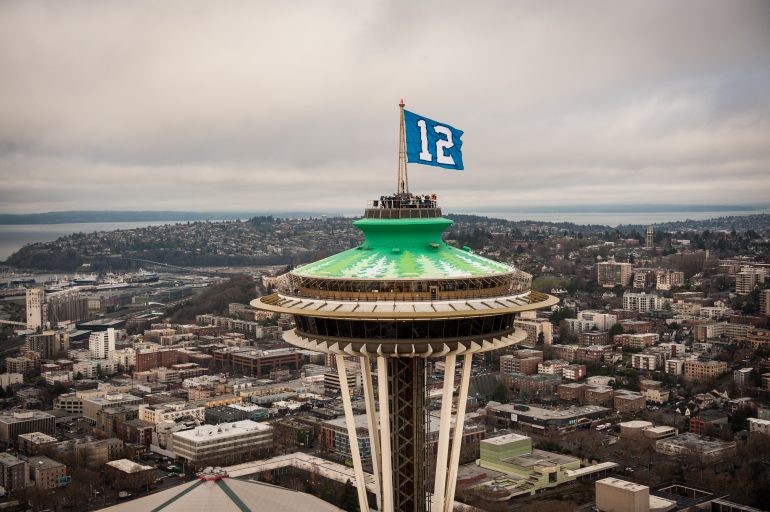The 2014 Seahawks are not the 2013 Seahawks. There are plenty of targets we could pin the blame on for that: injuries, personnel attrition in the offseason, coaching deficiencies, changes to the pass coverage rules, even a case of Super Bowl hangover (whatever the hell that means). That doesn’t mean that the ’14 Hawks are a bad team, mind you. Despite all their problems, the offense ranks 11th in the league in points scored and the defense is 7th in points allowed, but even so they haven’t looked like the unstoppable Super Bowl-bound juggernaut they were just a season ago.
But while scoreboard tallies and gut reactions are good enough to fuel bar stool debates and water cooler small talk, they’re pretty bad at giving us a sense of just what the hell is going on with our favorite team. To that end, I figured over the next couple weeks I’d try to focus a few articles on specific areas of the Hawks’ performance beginning with the passing game – y’know, crunch some numbers, do a little analysis, and present the resulting mess to you guys. Who knows, we might even learn something. Yay learning!
The Big Picture
Before we start throwing stats around, it’s important to understand what these numbers can’t do for us, and that’s definitively assign blame. There are a lot of factors that affect the passing game, including (but not limited to) the prowess of the QB, the blocking of the o-line, the performance of the receiving corps, the quality of the play calling (and the overall offensive scheme), whether the QB and his receivers are on the same page in every situation, etc. That doesn’t mean you can’t make some pretty good guesses based on the stat sheet, but if you really want to figure out who’s at fault numbers are a poor substitute for careful film study. And now that I’ve satisfied my overpowering urge to insert caveats into every article I write, on with the show.
First, the good. Wilson is a strong short-range passer. His completion percentage on throws to the short zones has improved incrementally from 69.28% in 2012 and 69.74% in 2013 up to 71.60% this season. I know it’s hard to get excited about short passes, but those are meat-and-potatoes plays for modern passing offenses – in Wilson’s case, short completions account for 60% or more of his total passing yardage each year. They aren’t flashy, but they keep the chains moving.
Unfortunately, the feel-good parade does not extend to the long range passing game, which has to be highly disappointing for Wilson. After posting 49.40% and 48.40% completion rates on passes to the deep zones in 2012 and 2013, respectively, he’s completed just 37.04% of his deep balls this year. To put that drop-off in perspective, among QBs with at least 20 deep pass attempts in a given season, Wilson’s completion percentage on long bombs was 3rd best in the NFL in 2012 and 4th in 2013. This year, he ranks 20th.
Doug Baldwin Stands Alone
Wilson’s favorite target by far this season has been Doug Baldwin. Number 89 has almost as many pass targets this year (54) as the team’s entire stable of running backs combined (55), and that favoritism extends nearly across the board. He has the most pass targets on the team or is tied for most in five of the six passing zones (Jermaine Kearse has him beat to the deep right); the most targets on first, second and third downs; the most targets in the first, second, third, and fourth quarters; the most targets in the final two minutes of a half; the list goes on.
And as Seahawks fans have learned over the last few years, a pass thrown Baldwin’s way is rarely a poor decision. This season, his catch rate is an impressive 69.70%, plus he’s racked up more receptions for first downs (28) than any other player on the team – almost twice as many as the next highest guy on the list (Kearse with 15) – with nearly half of those (13) coming on third down. In short, he’s making that 3 year, $13 million deal he signed back in May look like a better and better investment every week, especially when you compare it to the meager production-per-dollar return the team got back on the mammoth deals it gave to Sidney Rice and Percy Harvin.
Golden Tate’s Shoes Remain Unfilled
Of all the negative consequences of the failed Harvin experiment, one of the biggest has to be the team’s inability to offer a competitive contract to Golden Tate when he hit free agency. On paper, his averages for the Seahawks in 2013 (56.13 yds/game, 4.00 rec/game, 64.65% catch rate) painted him as a decent but not irreplaceable player, but so far no one has stepped up to replace his lost production.
Kearse would seem to be the logical choice to step into that role, but while his total stats are up from last year he’s still only contributing 34.55 yards per game and 2.36 receptions per game – numbers you’d expect to see from a third or fourth string role player, not a starting wideout. Additionally, his catch rate has dropped to 52.00% this year, down from 57.89% in 2013, with the bulk of that decline coming in the deep passing game. Overall, he’s been Wilson’s favorite target on deep throws in 2014, but the numbers don’t back up that decision – the two have connected on just 4 of 17 long passes for a dismal 23.53% completion rate, a sharp decline from the 8 of 16 (50.00%) he came down with in 2013.
Perhaps the area where the Seahawks miss Tate most is in explosive pass receptions (just as a reminder, I use Brian Billick’s definition of explosive passes as gains of 16+ yards rather than the NFL’s 20+ yards cutoff). Last year, Tate led the team with 21 receptions for explosive gains, or 1.31 per game, and so far nobody on the roster is threatening to come even close to that total – the leaders so far this year are Baldwin with 10 (0.91/G), Kearse with 8 (0.73/G), and Cooper Helfet and Marshawn Lynch with 6 apiece (0.75/G and 0.55/G, respectively). Harvin, by the way, contributed just one explosive pass reception in the five games he was with the team.
21 passes probably don’t sound like a lot, but explosive plays are a big part of the Seahawks’ offense. Last season, explosive passes made up just 28.84% of the team’s total completed passes, but those big plays accounted for 59.89% of the team’s total passing yardage (the numbers for 2012 were roughly similar). So far this season explosive plays have made up just 23.62% of the team’s completions and 53.90% of the team’s total passing yardage, which may not the biggest drop, but more than enough for the difference to be noticeable on the field – if you’ve been lamenting the offense’s lack of big-play ability through the air, now you know why (well, a big part of why, anyway).
The Fall and Rise of the Tight End
Another major issue this season has been the production, or lack thereof, of the Seahawks’ tight ends in the passing game. In the three weeks he played before being injured, Zach Miller averaged only two receptions per game, but those six passes he caught came on just seven targets for a catch rate of 85.71%. By contrast, his primary backup Luke Willson has caught 12 of 24 passes (50.00%), while third-stringer Cooper Helfet has produced a similarly lukewarm stat line with 10 receptions on 20 targets (50.00%).
But while Willson’s and Helfet’s numbers are a bit disappointing, a closer inspection shows there’s reason to expect some improvement over the next few weeks. Both TEs struggled through the first half of the season, with Helfet pulling in just 6 of 12 passes (46.15%) and Willson only managing to reel in 8 of 20 (40.00%). Since week ten, however, Helfet has caught 4 of 7 (57.14%) and Willson has racked up a perfect 4 of 4 (100.00%). The recent addition of Tony Moeaki has greatly improved the tight end group’s stats to the tune of 5 receptions on 5 targets.
Helfet has also emerged as one of the more consistent deep threats on the team, catching 4 of 7 for a catch rate of 57.14%. Willson, on the other hand, is much better in the short zones – he’s 1 for 5 on deep balls for a catch rate of 20.00%.
Everyone Else
Passes to running backs are up this year, which in a way is a small bit of good news. Scheming ways to get Lynch the ball in space is never a bad thing, especially since he’s sporting a catch rate of 72.97% (27 of 37) this year. Robert Turbin is not my favorite runner, but I’ve always thought he looked good as a receiving threat (78.00% career catch rate) so it’s been nice to see him getting more involved in the passing game, however small his role may be.
Paul Richardson was touted as a home-run burner when he was drafted back in April, but so far all his production has come in the short zones. He’s caught 13 of 17 passes at close range for a rate of 76.47%, but he’s 0 for 4 on deep passes. As for the other rookie, I love what I’ve seen from Kevin Norwood. He only seems to see the field as an injury replacement, but he’s made the most of his opportunities, reeling in 5 of the 6 passes thrown his way (83.33%). That breaks down to a perfect 5 for 5 on short passes and 0 for 1 on deep throws.
Ricardo Lockette has shown up relatively well with 8 receptions on 12 targets – 6 of 9 short and 2 of 3 deep for a 66.67% catch rate all around. Bryan Walters, on the other hand, has been less impressive with 5 catches on 10 receptions for a 50.00% catch rate. Interestingly enough, he’s one of the few players on the roster who didn’t see his opportunities in the passing game increase after the Harvin trade – since then, he’s had exactly zero balls thrown his way.

